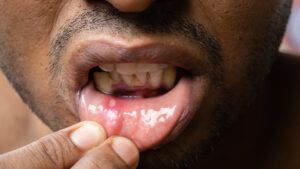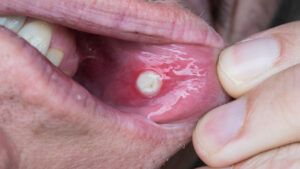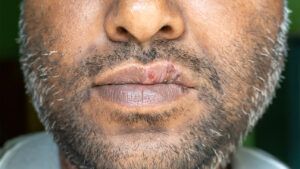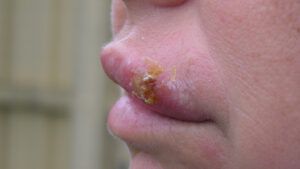Cold sores and canker sores are both common lesions that appear around the mouth and may look alike. However, their causes, symptoms, and treatments are different.
Canker sores are painful round or oval lesions that form on soft tissue inside the mouth, such as on the tongue or inner sides of the lips or cheeks.
Cold sores are caused by the herpes simplex virus (HSV). They can appear on or around the lips, but they may develop elsewhere on the face or on the tongue, gums, or throat.
Below, we compare the symptoms and treatments of canker sores and cold sores.
The following slideshow shows images of canker sores and cold sores on the lips.




When trying to identify a canker sore or a cold sore to find the right treatment, it can help to know about the following differences:
Canker sores
Canker sores form in the softer areas inside the mouth, such as the tongue, cheeks, lips, and soft palate. These sores are
They heal without treatment but may reappear at the same location or in a different spot.
There are three forms of canker sores, which are medically known as aphthous ulceration:
- Minor aphthous ulcers: These sores are under 5 millimeters (mm) in diameter. They heal within about 1 to 2 weeks without causing scars.
- Major aphthous ulcers: These sores are typically larger than 10 mm in diameter. They can last for more than a couple of weeks and can cause scarring.
- Herpetiform ulcers: These are clusters of tiny sores that sometimes merge to form larger ones. They may take up to 1 month to heal. They usually occur on the tongue.
Cold sores
During childhood, many people develop an infection with HSV that is responsible for cold sores. People may also refer to cold sores as fever blisters.
Some people never develop symptoms. If symptoms occur right after the initial infection, during childhood, they may include:
- a burning sensation, then the formation of painful sores — cold sores — on the lips, gums, tongue, or throat
- pain while swallowing
- fever
- sore throat
- swollen lymph nodes
- nausea
- headaches
- other aches and pains
These symptoms may last for around 1 to 2 weeks.
Cold sores can reappear, but the outbreaks typically become less severe over time. Symptoms of a cold sore follow a three-step pattern:
- A person may feel a burning, itching, or stinging sensation in a spot on or around the mouth.
- A fluid-filled blister, the sore, develops at the spot.
- The blister breaks, oozes, and crusts over, all within about 48 hours of the initial sensations.
In people who are healthy, cold sores usually disappear within 5 to 15 days, without causing scarring. If a cold sore lasts longer than 15 days, a person should receive medical attention.
Also, anyone with a cold sore near their eyes should see a doctor immediately.
Cold sores are contagious. People should wash their hands well and regularly to prevent HSV transmission to other individuals.
Understanding the underlying causes can also help a person differentiate between the two types of lesions.
Canker sores
While the exact cause of canker sores is still a mystery, they may result from immune system dysfunction in the soft tissue lining of the mouth.
Some possible triggers of canker sores
- stress
- lack of sleep
- injuries, for example from biting the lip or inside of the cheek
- smoking
- certain foods, toothpastes, or medications
- deficiencies in folic acid, iron, or vitamin B12
- menstruation
- viral infections
Anyone who has canker sores and any of the following symptoms should speak with a doctor:
- fatigue
- abdominal pain
- fever
- eye discomfort
- rashes or sores elsewhere
It is a good idea to notify a dentist if more than three canker sore outbreaks occur each month or any canker sores do not resolve within 10 to 14 days.
Cold sores
A form of HSV causes cold sores. Once the virus enters the body, it never leaves.
People with cold sores can transmit HSV through:
- kissing
- oral sex
- sharing utensils
- sharing personal items, such as towels
Triggers for cold sore outbreaks include:
- stress
- fatigue
- illness, such as a cold
- injury to areas where sores once appeared
- dental work
- cosmetic surgery
- sunburn or just exposure to strong sunlight
- certain foods
- hormonal changes, such as during menstruation
Learn about the causes of recurrent cold sores.
Cold and canker sores respond to different treatments.
Canker sores
Canker sores
Treatments for canker sores fall into a
- Occlusive agents: These are protective coatings that shield nerve endings and protect against irritation from temperature changes and certain foods. One example is benzyl alcohol gel.
- Cleaning agents: These clear bacteria and debris from the surface of the lesion. Examples include mouthwashes containing chlorhexidine or triclosan.
- Local anesthetics: These drugs reduce pain. Examples include lidocaine and benzocaine.
- Nonsteroidal anti-inflammatory drugs (NSAIDs): NSAIDs help reduce inflammation and pain. Doctors may recommend medications containing the NSAID diclofenac.
Additionally, some people may want to try astringents, which narrow the blood vessels in the mucous membranes near the canker sore. These may include plant-based remedies with ingredients like myrrh or rhubarb root. However, a person should speak with a healthcare professional before doing so.
Sometimes, an ingredient in toothpaste called sodium laureth sulfate can trigger canker sore outbreaks. Some people may benefit from avoiding toothpastes that contain it.
People may also want to try avoiding spicy foods and managing other possible canker sore triggers.
If sores are moderate to severe, avoid self-treatment and consult a doctor.
Read about treating canker sores.
Cold sores
In many cases, cold sores resolve on their own without treatment. However, treatment can shorten the duration of cold sore outbreaks and may help prevent transmission of HSV to others.
Depending on the severity of a cold sore outbreak, a doctor may prescribe topical or oral antiviral medications.
Some prescription antiviral treatments include:
- topicals such as:
- docosanol cream
- penciclovir cream
- acyclovir cream
- oral drugs such as:
- acyclovir pills
- valacyclovir pills
- famciclovir pills
Some people require pain relief medication, such as topical lidocaine.
To prevent cold sores on the lips from worsening, a person can apply lip balm with an SPF of 30 or higher.
Learn about treating cold sores.
It is not always possible to prevent canker sores or cold sores from forming. However, the following strategies may help.
Canker sores
A person may want to try keeping track of when canker sores appear in a symptom journal.
This can help a person detect any triggers, which may involve foods, types of toothpaste or mouthwash, and lifestyle factors.
Cold sores
To possibly prevent cold sores from appearing, doctors recommend using antiviral treatment at the first warning sign, which may be a burning or stinging sensation.
In some cases, a doctor may prescribe a low dose oral antiviral medication as a preventive treatment for someone who experiences recurrent cold sore outbreaks. Alternatively, they may prescribe lysine.
Several other health issues can cause lesions that may look like cold or canker sores, including:
- certain blisters
- injuries
- autoimmune conditions
- oral cancer
Anyone who is unsure about the type or cause of a lesion in, on, or around the mouth should speak with a doctor.
Cold sores and canker sores are both common, and they may look alike. However, their causes, symptoms, and treatments are different.
Canker sores typically occur on soft areas inside the mouth. Though cold sores may also appear on the tongue, throat, or gums, they tend to form on or around the mouth.
HSV causes cold sores, but doctors are still unsure of the exact cause of canker sores.
Cold sores require treatment to prevent HSV transmission between people, while canker sores typically disappear on their own.


